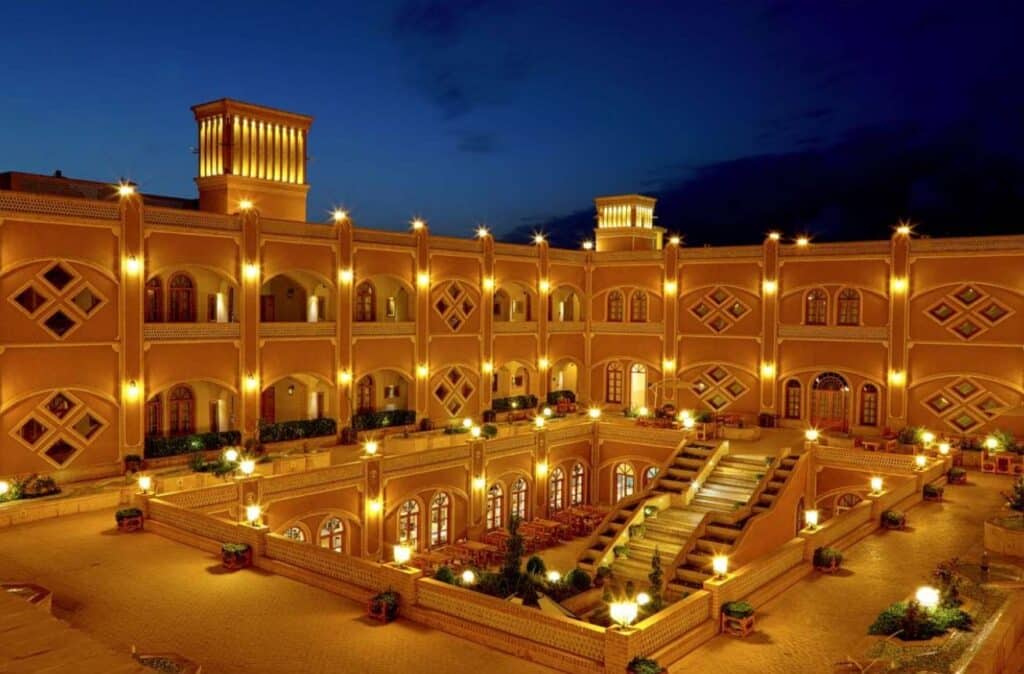Khan Bazaar in Yazd
Introduction to Yazd Khan Bazaar with all its attractions and sights

Yazd Khan Bazaar, located in the heart of Yazd, Iran, is a vibrant and historically rich marketplace. This bustling bazaar stands as a testament to the city’s age-old trading history and cultural heritage. It’s a place where the past and present merge, offering an authentic experience of Iranian culture and commerce.
As you step into Yazd Khan Bazaar, you’re immediately greeted by the lively atmosphere. The air is filled with the aroma of spices and the sounds of merchants and shoppers. The bazaar’s architecture is a marvel in itself, featuring intricate Islamic designs and a network of narrow alleys covered by high arches. These architectural elements not only create a visually stunning environment but also provide much-needed shade in the hot desert climate.
One of the highlights of the bazaar is its array of shops. From traditional Persian carpets to handmade jewelry, the range of products available is vast. Each shop is a treasure trove of local crafts, offering visitors a chance to purchase unique souvenirs and gifts. The skill and craftsmanship evident in these products reflect the rich artisanal heritage of Yazd.
The bazaar is not just a shopping destination; it’s a social hub. Here, you can observe the daily life of Yazdis. Conversations over cups of steaming tea, the exchange of news and greetings among locals, and the haggling over prices, all add to the bazaar’s dynamic atmosphere.
Food enthusiasts will also find Yazd Khan Bazaar to be a delight. Traditional Iranian snacks and sweets, such as baklava and qottab, are available at various stalls. The flavors and recipes, passed down through generations, are a true reflection of Yazd’s culinary traditions.
Contents
Yazd Khan Bazaar Along the Silk Road
The exchanges that took place along the Silk Road once traversed through this market and its alleys, which still serve as a sanctuary for traditional and enduring crafts such as blacksmithing, copperwork, gold, and jewelry craftsmanship in Yazd.
Interestingly, during the Qajar era, visiting this market might not have been allowed unless you were nobility or Khan!
Here, in SURFIRAN Travel Magazine, we’ll take you through both the aristocratic and historical aspects of Yazd’s market.
Yazd Khan Bazaar: Qajar Era to Present
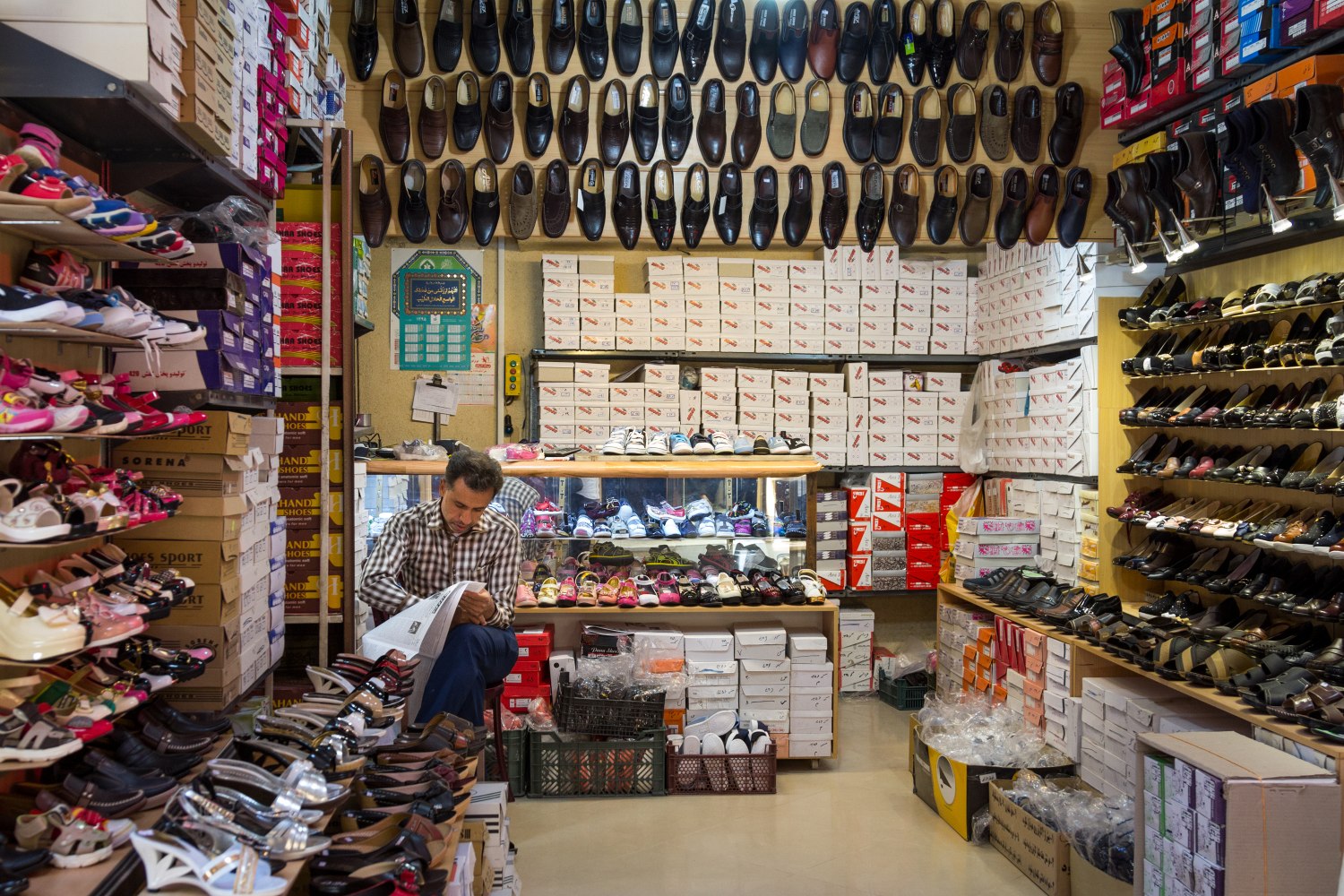
Traveling back to Yazd’s Qajar era, the sight of the city’s evolving landscape would amaze you. Today, while much has changed, Yazd Khan Bazaar maintains its historic essence. The market’s original structure, bricks, and chambers remain intact, proudly preserving its historical fabric amidst modern transformations.
Today, when you visit Yazd Khan Bazaar in the age of technology, you can experience traditional shopping and the joy of traveling back in time. You can also purchase various famous handicrafts from Yazd in this market.
Explore the historical sites around Yazd Khan Bazaar, which are of historical significance to this ancient market. Overall, have a thoroughly recreational and captivating journey, especially since this market provides easy access to Khan Bathhouse, Khan Square, Khan Theological School, Shahzadeh Fazl Shrine, Yazd Water Museum, and more. Combining the historical shopping experience with visits to historical sites makes it an unforgettable experience!
Yazd Khan Bazaar: Its Age Revealed
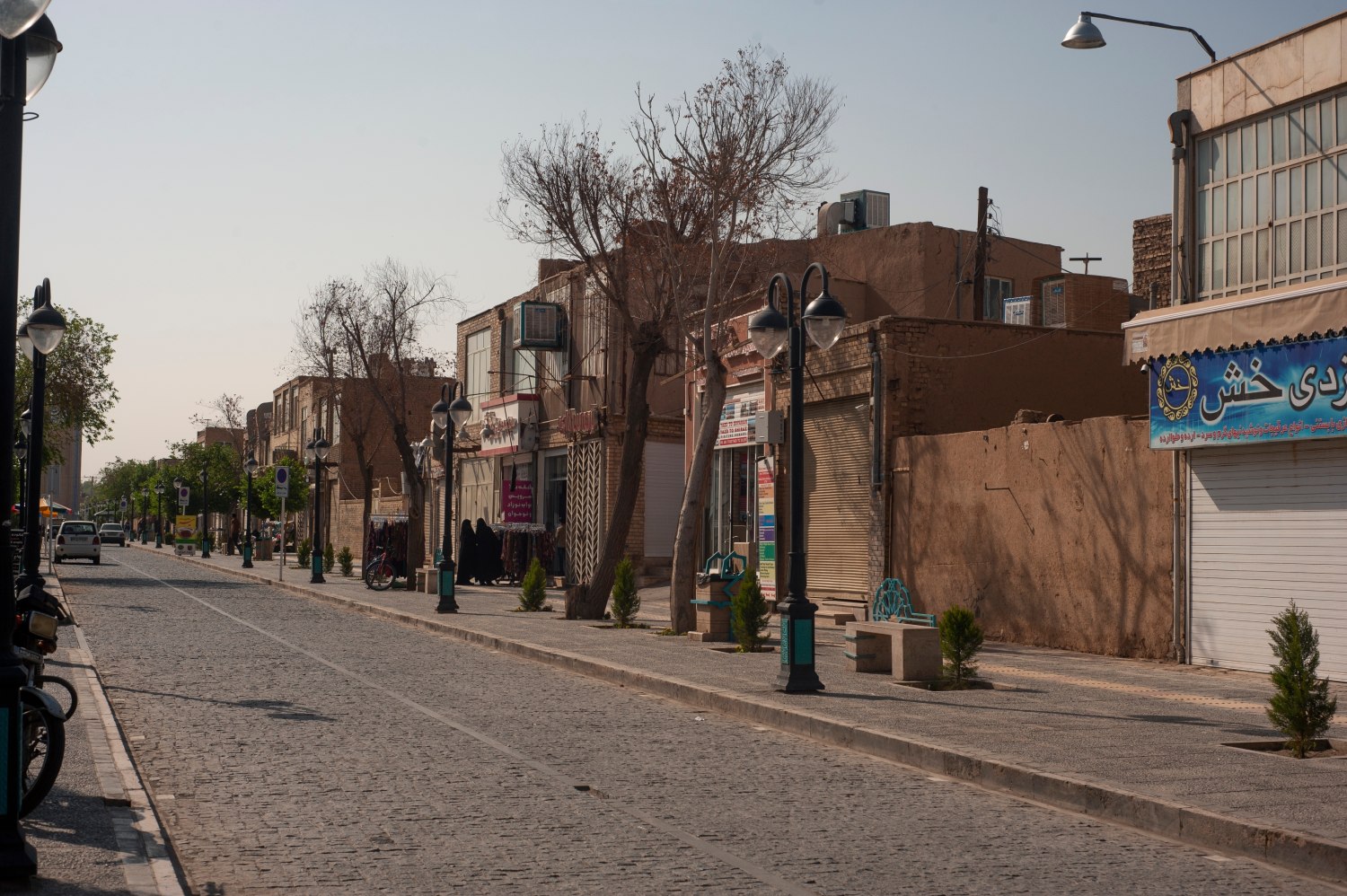
Like many of Yazd’s attractions and historical monuments, Yazd Khan Bazaar traces its origins back to the Qajar period. This vast and expansive market was constructed during the reign of Naser al-Din Shah Qajar and gradually expanded, becoming today’s longest-standing traditional market in Yazd.
While it’s true that this market was built during the Qajar era under the supervision of Mohammad Taqi Khan Bafghi, it was his descendants who took on the responsibility of completing the market in the following years. Mohammad Taqi Khan Bafghi, the founder of the Khavanin dynasty and one of the rulers of Yazd during the Qajar era, left behind many remarkable monuments in Yazd during his lifetime, such as Dolat Abad Garden, Qeisariyeh Bazaar, Khan Square, Golshan Garden, and Khan Theological School.
The Khavanin complex, which includes Yazd Khan Bazaar, Khan Bathhouse, Khan Square, and Khan Theological School, was all established by Mohammad Taqi Khan Bafghi and his descendants, and they are considered some of the most beautiful attractions in Yazd. Additionally, in 2003, on the 9th of Ordibehesht (the second month of the Iranian calendar), Yazd Khan Bazaar was registered as a national heritage of Iran, securing its historical significance for eternity.
Why is it named Yazd Khan Bazaar?
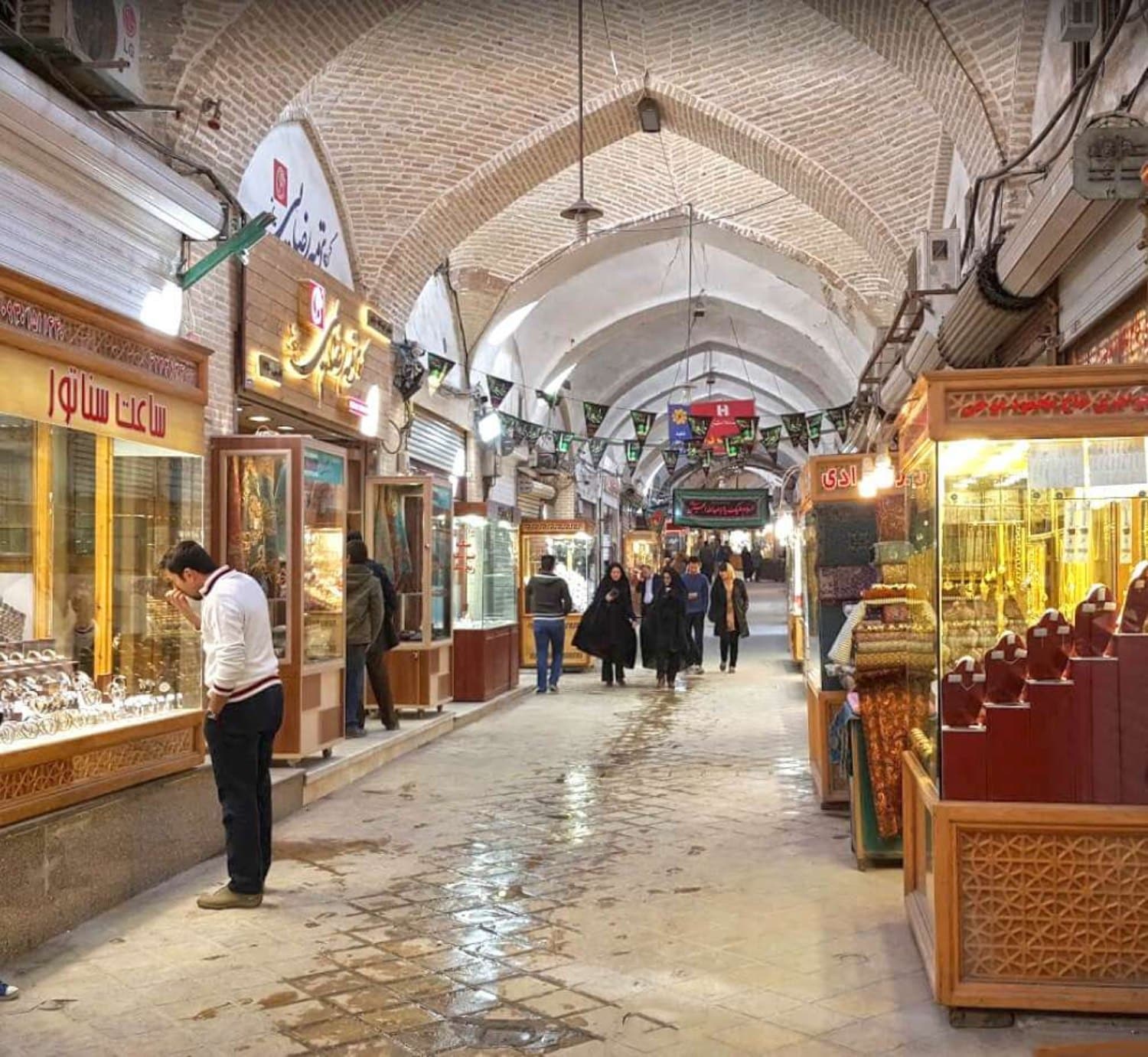
You might have thought, like me, that it’s named after Mohammad Taqi Khan. However, the real story behind this name is more intriguing and hides the lifestyle of the Qajar era and its people:
In ancient Yazd, only nobles or prominent individuals known as “Khan” had the right to enter this magnificent market. The commoners and lower classes of society were not allowed to enter or even approach the market. This naming convention stemmed from the social inequalities prevalent in Iranian society, and it’s what led to the enduring name of this market as Khan Bazaar.
The Longest Bazaar in Yazd
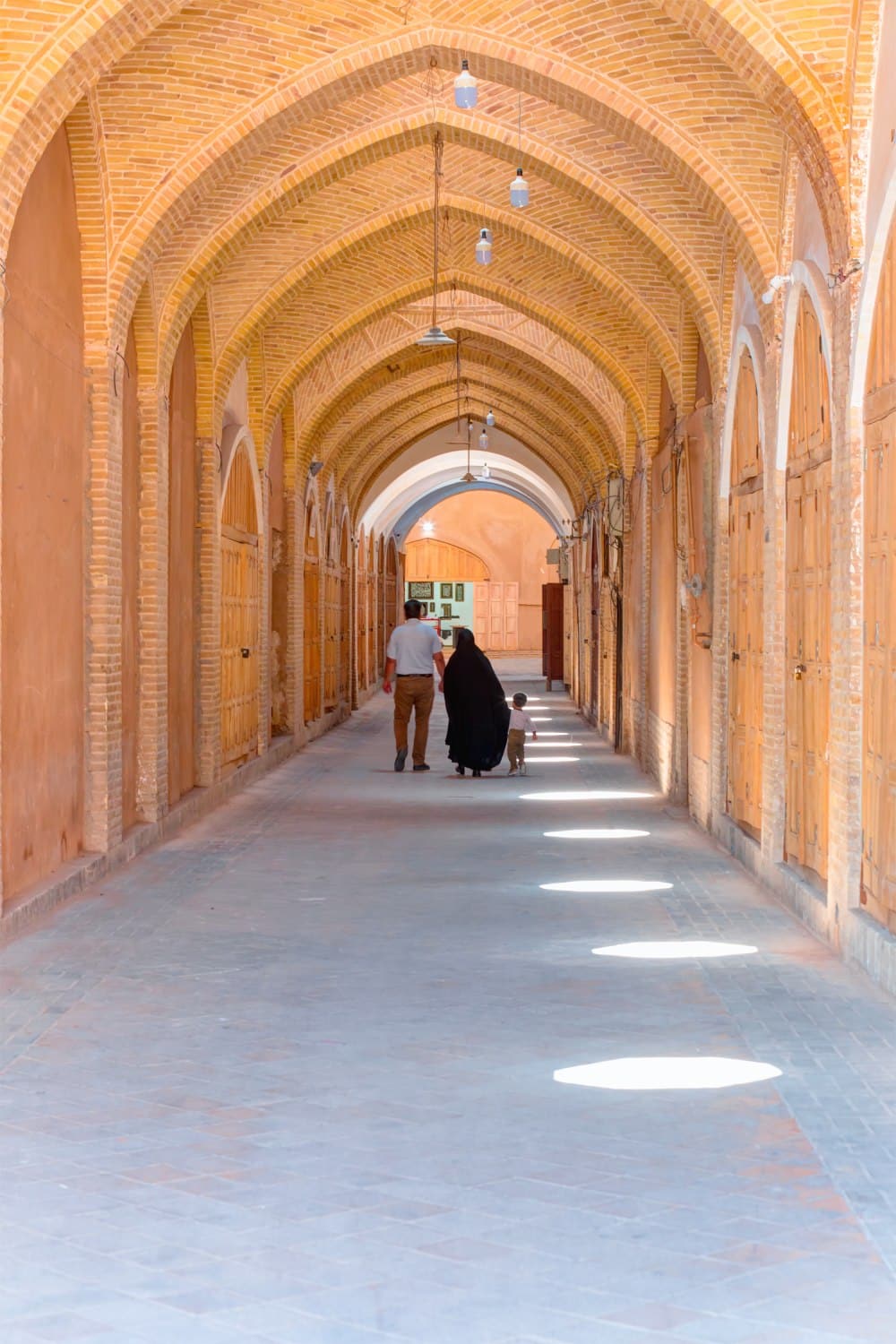
Yazd Khan Bazaar stretches for 274 meters, extending from the Khan Complex, including Khan Bathhouse, to Shahzadeh Fazl Shrine, which is situated on the other side of the streets. The ceiling of this bazaar varies in height from 4 meters to 6 meters, mainly due to the gradual construction process of this ancient market in Yazd.
This historical and traditional bazaar is divided into two parts, the northern-southern and the eastern-western sections. The northern-southern section is shorter, measuring 78 meters in length with 53 shop entrances. In contrast, the eastern-western section of Yazd Khan Bazaar is longer, spanning 180 meters with 100 shop entrances. Even from these descriptions, it becomes apparent that the architecture of this market is unique and visually captivating!
It’s important to note that Yazd Khan Bazaar consists of smaller sub-markets, such as the Goldsmiths’ Bazaar, Panjeh Ali Bazaar, Alaqqabandi Bazaar, Molla Ismail Bazaar, Kashigari Bazaar, Afshar Bazaar, Chitsazi Bazaar, Copper Bazaar, Shahzadeh Fazl Bazaar, Darvaze Mehriz Bazaar, and Nakhodbirizha Bazaar.
The Qajar Era Splendor of Yazd Khan Bazaar
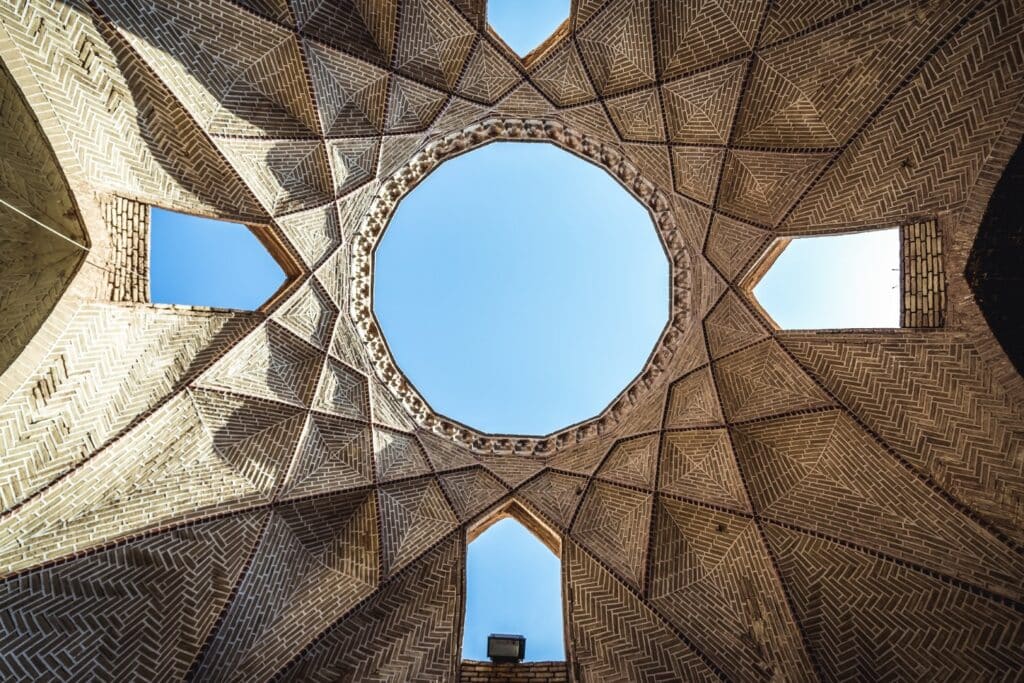
While we’ve discussed the length, height, and shop entrances in the northern-southern and eastern-western sections, let’s take a moment to visualize how the architecture of Yazd Khan Bazaar has taken shape and the atmosphere it imparts to those who walk beneath its eastern archways.
The walls and archways of Yazd Khan Bazaar are entirely constructed from bricks, clay, bricks, and gypsum. This choice of materials has made this market a cool and shaded environment, even during the hottest seasons in Yazd.
In the construction of this ancient and lengthy market, which has a long history, small caravanserais, known as “teimcheh,” were built, creating a somewhat intricate and maze-like layout. What do we mean by “teimcheh”? In essence, a teimcheh is a small caravanserai used as a resting place within traditional markets.
As each section of Yazd Khan Bazaar has its own unique name, its architecture also varies depending on the profession that dominates that particular section of the market. However, from the perspective of tourists and enthusiasts, the architecture of Qeisariyeh Bazaar, located between Khan Square and Khan Theological School, is the most beautiful and noteworthy part of the market.
Yazd Khan Bazaar boasts two wooden doors, which are still used to open and close the market. The overall architecture of the bazaar is connected through a main corridor or “daalan,” and if you look at the extension of these corridors, you’ll notice that the archways on the ceiling, systematically placed, resemble the spiral shell of a snail. This unique architectural feature transports you under the open sky of Yazd in various directions.
From Khan Bazaar to Khan Bathhouse
By now, you surely know that Yazd Khan Bazaar, designed by Mohammad Taqi Khan Bafghi, is part of the larger Khan Complex, which includes several renowned historical sites in Yazd.
Qeisariyeh Bazaar of Yazd
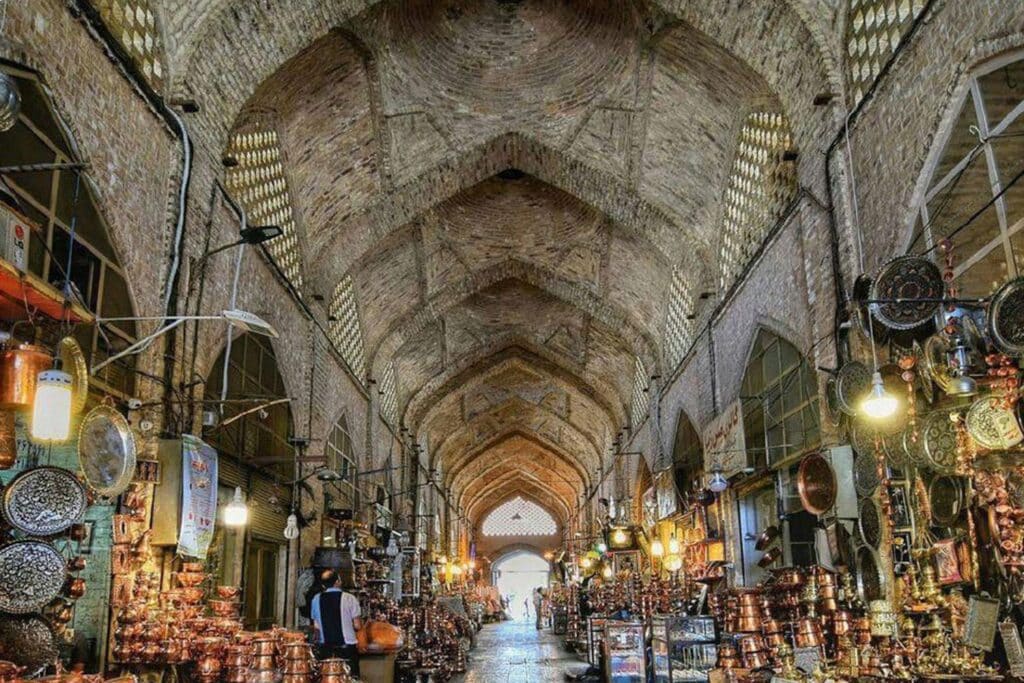
The Jewel of Khan Bazaar This bazaar, which essentially forms the textile-selling section of Yazd Khan Bazaar, is one of the five famous Qeisariyeh Bazaars in Iran. Yes, other cities also have Qeisariyeh Bazaars, and interestingly, they are historical cities like Isfahan, Shiraz, Kerman, and Qazvin. However, the charm of Qeisariyeh Bazaar in Yazd is just as exemplary, if not more so.
Qeisariyeh Bazaar in Yazd is a sub-alley with daalans and teimchehs, historically designated for precious and valuable goods. This bazaar, located between Khan Square and Khan Theological School, opens and closes with two wooden doors at its ends.
Architecturally, compared to other sections of Yazd Khan Bazaar, Qeisariyeh Bazaar exhibits a more sophisticated and organized design. The colorful and beautifully arranged textile shops in Yazd provide a feeling of strolling amidst chambers adorned with curtains and fine fabrics.
Khan Square in Yazd
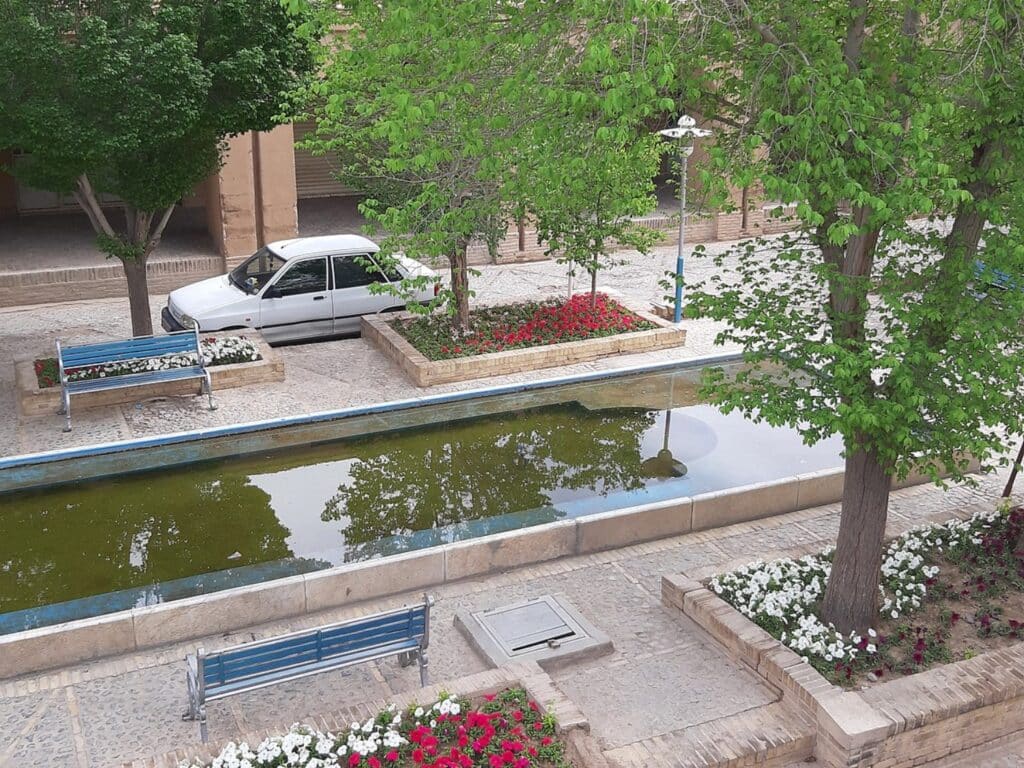
Yazd Square is also part of the Khan Complex, providing access not only to Yazd Khan Bazaar but also to Khan Bathhouse. When you gaze at this square from a distance or walk among its small gardens, you’ll feel as though you’re in a serene and beautiful park, infused with the historical essence of Yazd.
This square was also constructed during the Qajar era by Mohammad Taqi Khan Bafghi and served as one of the main squares in Yazd at the time. Around the four sides of the square, you’ll find shops with ancient awnings and crescent-shaped doorways. In the northern border of Khan Square, Khan Theological School (Shefaeiye) catches your eye. Like Yazd Khan Bazaar, this square, along with the surrounding markets, has been registered as a national heritage of Iran.
School of Khan and the Hidden Underground Passage
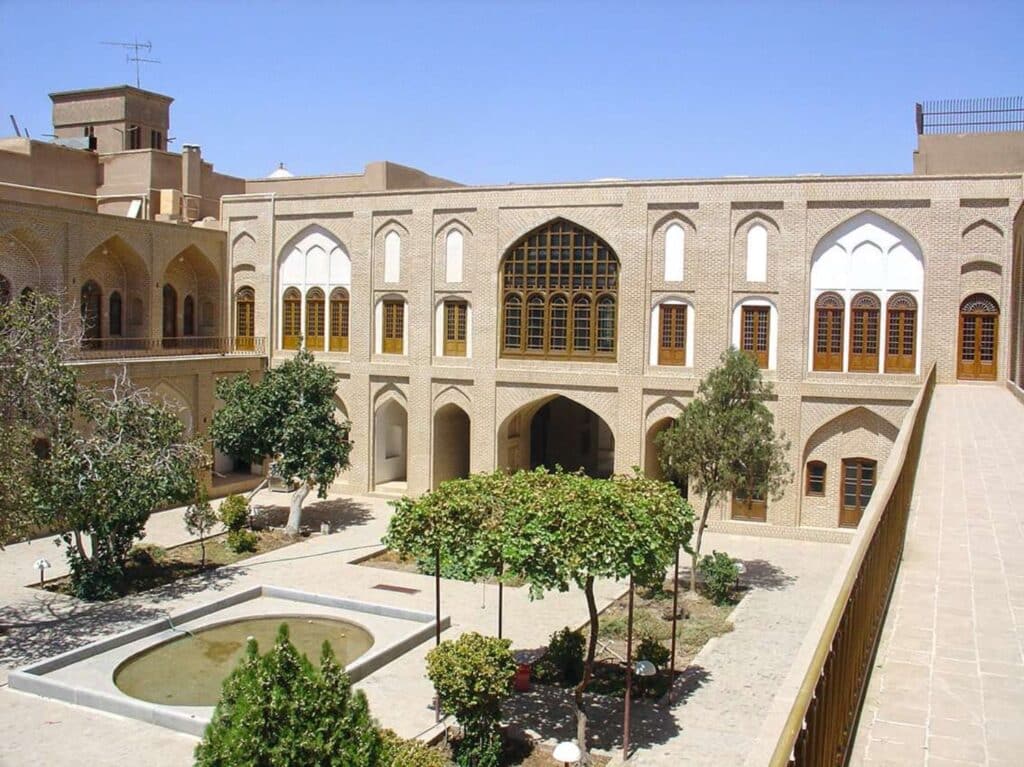
The School of Khan in Yazd, which is now one of the city’s important religious seminaries, was constructed during the Qajar era by Mohammad Taqi Khan Bafghi and covers an area of approximately 2910 square meters. The school’s building is so large that it consists of two symmetric courtyards and a large central courtyard, accompanied by a two-story structure with 78 rooms.
The architectural style of the School of Khan in Yazd, which captivates the eyes of every tourist, dates back to the late Zand era and early Qajar era. It is considered one of Yazd’s attractions and important historical sites.
However, this school has a very special and interesting feature, which is its underground passage. The School of Khan in Yazd has an underground passage that connects it to the Mosque School of Yazd, indicating that in the past, the teachers and students of these religious schools were in communication through this underground route.
Furthermore, this seminary has a very rich library, founded by “Ayatollah Oloumi,” with more than 11,000 valuable books and 133 historical manuscripts, which are like a treasure trove located within the heart of this school.
Given its historical significance and unique architectural style, the School of Khan in Yazd, which is very beautiful, coordinates visits for tourists and those who want to explore the school during hours when the seminary students do not have classes. The School of Khan in Yazd, along with Khan Bazaar and Khan Square, is registered as national heritage sites in Iran.
Khan Bathhouse (Garmkhaneh-e Noor)
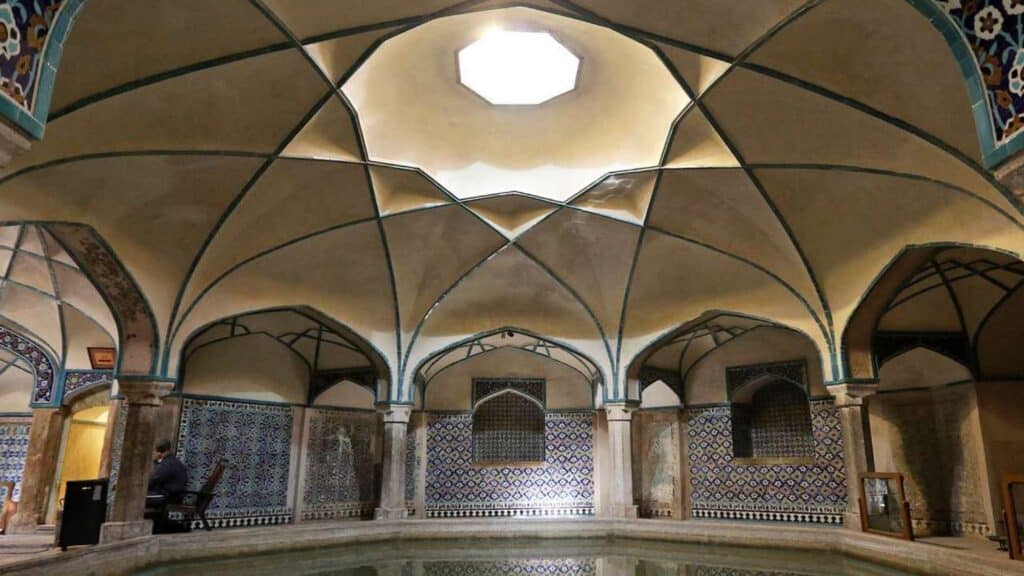
The construction of Khan Bathhouse in Yazd took many years, and during the Qajar era, it was mainly used by the nobility and Khans, while commoners could gather in a separate section of the bathhouse for discussions, conversations, and cleanliness.
Khan Bathhouse is divided into sections such as Miandar (changing room), Beeneh (hot room), Garmkhaneh (steam room), Gavroof, Tooyeh, support area, Toon, Qorineh, Sareeneh, and the entrance. It includes a pool with an area of approximately 6 by 12 meters, which was the central part of various sections of Khan Bathhouse.
Other spaces such as the cloakroom, shoemaking area, and benches are beautifully and uniquely designed within this bathhouse. For example, the walls in the Sareeneh section of Khan Bathhouse were adorned with nude paintings in the past, but unfortunately, only a few traces of them remain today.
The Garmkhaneh (steam room) section of Khan Bathhouse is particularly delightful due to its domed ceiling and the columns supporting it. The Shah Neshin (royal seating) section of the bathhouse features colorful walls adorned with designs depicting characters from the Shahnameh (Book of Kings), which were added during the Qajar era when the bathhouse was reconstructed.
With its charming and beautiful design, Khan Bathhouse in Yazd, along with its light wells, colorful windows, and decorative plasterwork on the ceiling, ranks as one of the most beautiful historical bathhouses in Iran and is considered a national treasure.
Cafe Adasi Panahande, Culinary Delights in Khan Bazaar
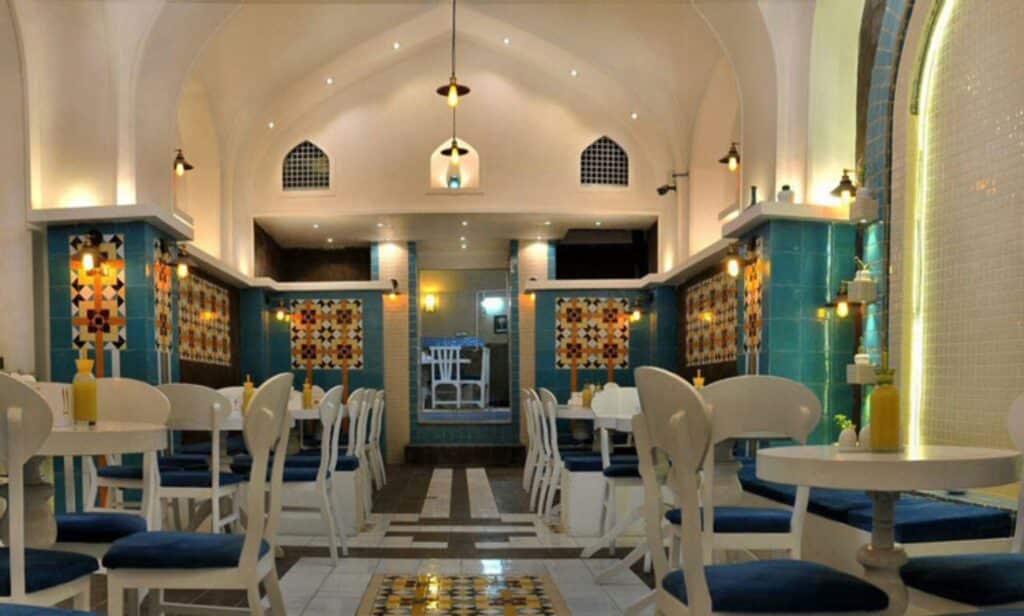
One of the most fascinating and delicious parts of Khan Bazaar in Yazd, where you can embark on a culinary adventure, is Cafe Adasi Panahande. This cafe is one of the oldest cafes in Yazd, established 60 years ago, which means it has been serving for over half a century!
One remarkable feature of this cafe is that it has never been closed during these 60 years, which means you can visit this cafe anytime and satisfy your cravings. It attracts visitors from all walks of life, including students, market-goers, and even well-known individuals from Yazd, making Cafe Adasi Panahande a beloved local spot.
Cafe Adasi Panahande is located in the Panjeh Ali section of Khan Bazaar in Yazd, surrounded by shops selling Yazd’s handicrafts. While the cafe offers a diverse menu, what has contributed to its fame, even to its name, is its famous, delicious, and hot Adas (lentil soup), a specialty of the cafe that has been enjoyed from ancient times to the present.
Ab-Anbar at Mehriaz Gate, a Relic from the Safavid Era
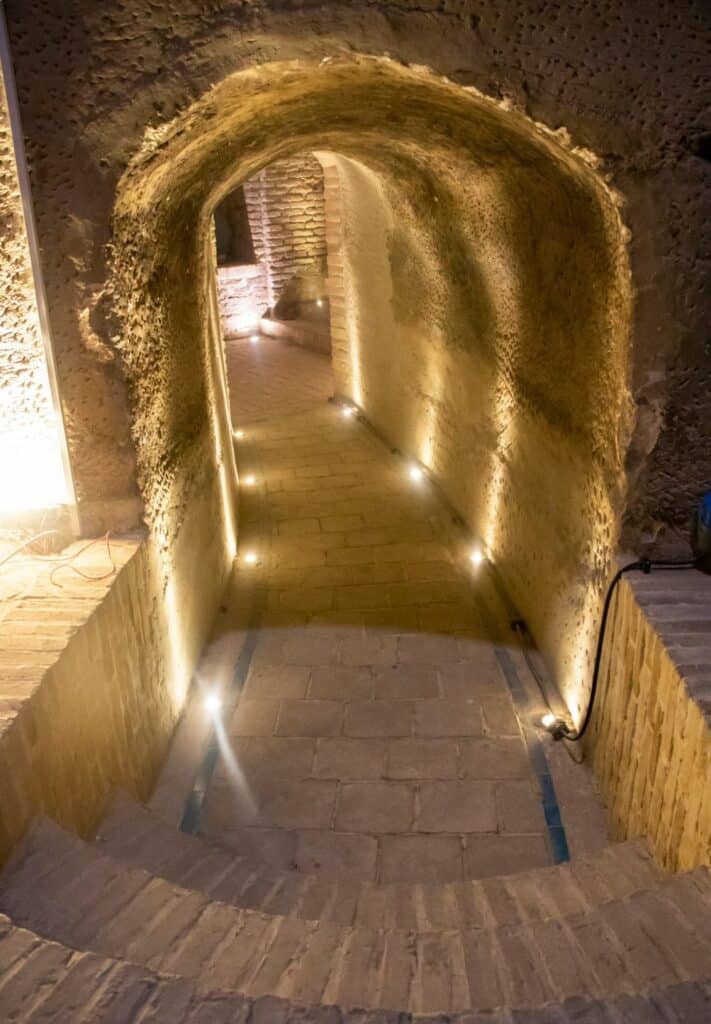
In the Mehriaz Gate section of Khan Bazaar in Yazd, located in the northern part of Qiyam Street, there is an ancient Ab-Anbar (water reservoir) that has access to Yazd’s qanats (underground aqueducts). The history of this Ab-Anbar dates back to the 11th century AH (Islamic calendar) during the Safavid era and is among the water reservoirs that were constructed outside the city. It served not only as a place for water storage but also as a recreational and interurban resting place.
The Ab-Anbar at Mehriaz Gate, like many other sections of Khan Bazaar in Yazd, is registered as a national heritage site in Iran. The building of this water reservoir includes a corridor with 63 steps, a light well, a qanat, a resting area, and a water tank. Intricate designs from the Safavid era adorn its walls.
In recent years, the Ab-Anbar at Mehriaz Gate has been entrusted to the private sector by the Office of Endowments of the Country for restoration and revival. Prior to that, it had been a neglected and somewhat abandoned place, serving as a dumping ground. However, now, after being handed over, efforts are being made to restore and reconstruct it into a center to attract tourists and visitors to Khan Bazaar in Yazd.
What Can You Buy?
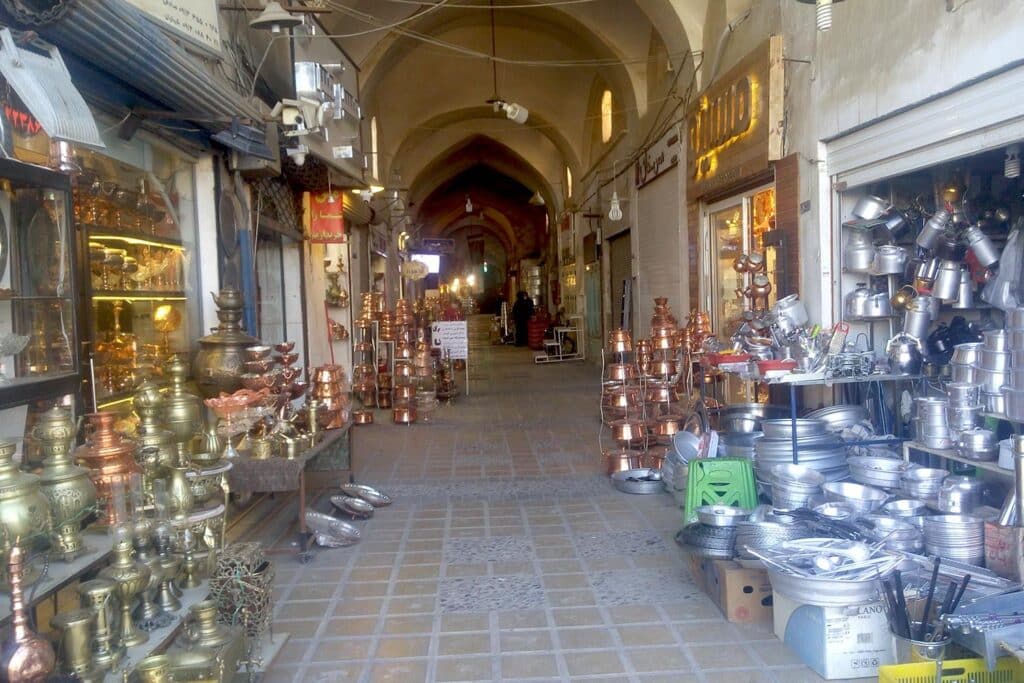
In the Khan Bazaar of Yazd, you can find various shops and rooms with old wooden or metal doors, diverse aisles, and enticing nooks that transport you to the world of vintage Iranian films. From early in the morning, people bustle and haggle in the market, beginning their day with scents and colors.
The Gold Market, located within the Khan Bazaar, is the hub for gold trading and is like a gem that shines even from a distance among the bricks and walls of the market. The arches and crescent-shaped ceilings of the Gold Market take you back in time while presenting you with one of the most up-to-date and renowned markets for buying and selling gold and jewelry in Yazd.
The Mehriaz Gate Market, situated in the northern-southern part of the Khan Bazaar, concludes with Darolshafa Alley, and the Mehriaz Gate Water Reservoir is also located in this part of the market, destined to soon become a major attraction for both foreign and domestic tourists.
The Tile Market, which includes the blacksmiths’ guild, was established during the Afsharid era and offers various handmade metal products in this section of the Khan Bazaar in Yazd. And finally, the Panjeh Ali Market, known as the Coppersmiths’ Market, is filled with the sound of hammers and the work of coppersmiths who have kept this part of the Khan Bazaar in Yazd vibrant from ancient times to the present day. It is also a popular destination for travelers to purchase high-quality copperware and souvenirs.
When Should You Go for Shopping?
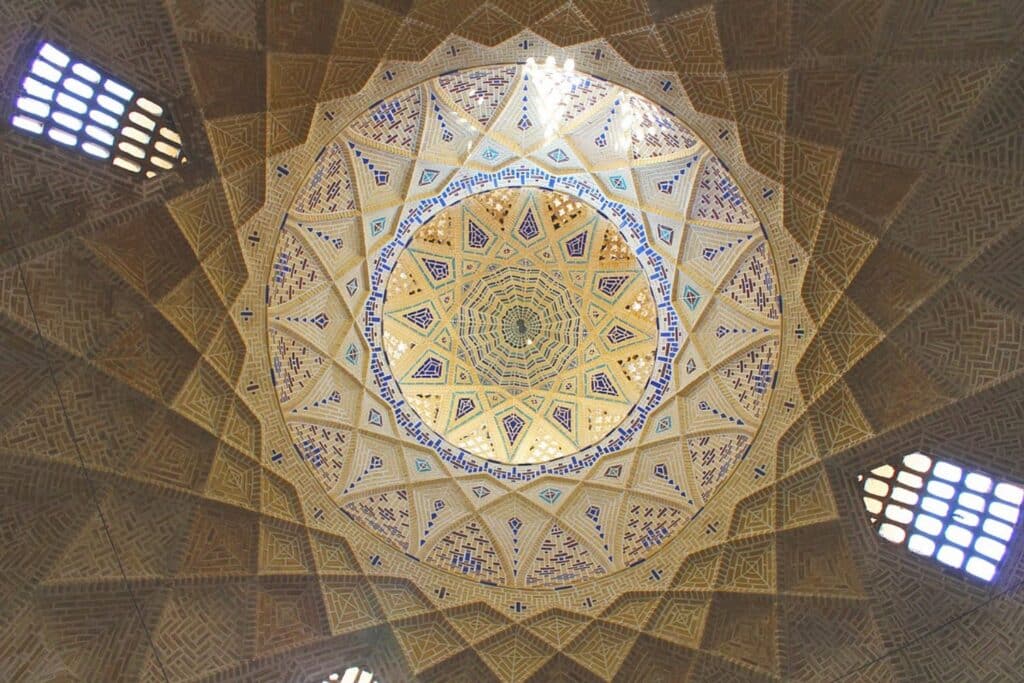
Imagine you have traveled to the city of Yazd and want to dedicate a day to exploring the bazaar and shopping. What is the best time to visit the Khan Bazaar in Yazd? Is it when the sun is just rising, and the market’s shopkeepers are opening their doors, or is it when the afternoon has passed, and the market is bustling with activity, scents, and colors?
Considering the popularity of the Khan Bazaar in Yazd among both tourists and locals, perhaps the best time for market exploration amid the various trades and shops is during weekdays in the afternoon when all shops are open, and traditional restaurants inside the market have prepared enticing offerings for your culinary adventure in the Khan Bazaar in Yazd.
Khan Bazaar Opening Hours
During the first half of the year, you have more time for a leisurely shopping experience, as you can visit the Khan Bazaar in Yazd from 8 AM to 10 PM. In the second half of the year, the Khan Bazaar in Yazd opens from 7 AM and remains open until 6 PM, allowing you to explore among the market’s shops and rooms.
Where Is Khan Bazaar?
To reach the Khan Bazaar in Yazd, you can use various means of transportation such as taxis and buses. Fortunately, no matter where you are in Yazd, you can find buses and taxis that will take you to Imam Khomeini Street, and from there, you can walk to the Khan Bazaar. The Khan Bazaar is easily accessible from anywhere in the city, making it convenient for your visit.
Address: Yazd, Imam Khomeini Street, Qaem Street, Khan Bazaar Yazd.
How to Get to Khan Bazaar?
To reach the Khan Bazaar in Yazd, you can use various means of transportation such as taxis and buses. Fortunately, no matter where you are in Yazd, you can find buses and taxis that will take you to Imam Khomeini Street, and from there, you can walk to the Khan Bazaar or take a taxi to reach the entrance of the market.
Wrapping Up
Bring the experience of shopping in one of Yazd’s oldest and most beautiful markets to your home! The Khan complex, including the Khan Bazaar, Khan Bathhouse, School, and Khan Square, as well as the historical Mehriaz Gate Water Reservoir, can turn this area into one of the most historical districts in Yazd.
It’s a place where you can find relaxation and therapy in the art and handicrafts of Yazd while letting your mind wander among its high arches. You can explore from one market to another, savor traditional cuisine at the Khan Bathhouse restaurant, or visit Cafe Adasi Panahande. Taste the delights and make this journey more and more dreamlike.
Read More
